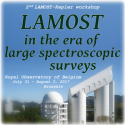Speaker
Mr
David S. Aguado
(Instituto de Astrofísica de Canarias)
Description
The most metal-poor stars in the Milky Way witnessed the early phases of the formation of the Galaxy, and have chemical compositions close to the pristine mixture from the Big Bang nucleosynthesis, polluted by one or very few supernovae. Here we present a program to search for and characterize new ultra metal-poor stars in the Galactic halo. These stars are extremely rare: despite significant efforts, only a handful of stars have been identified with a metallicity [Fe/H]< -5 dex. We select candidates from SDSS and LAMOST. Dozens of them have already been observed with the ISIS spectrograph on the 4.2-m William Herschel Telescope. The most interesting objects have been confirmed with the Optical System for Imaging and low-Intermediate-Resolution Integrated Spectroscopy (OSIRIS) on the 10.4-m Gran Telescopio Canarias (GTC) and the High Resolution Spectrograph (HRS) on the 9.2-m Hobby-Eberly Telescope (HET). Our analysis is highly automated, and based on the FERRE code (Allende Prieto et al. 2006, ApJ, 636, 804).
Primary author
Mr
David S. Aguado
(Instituto de Astrofísica de Canarias)
Co-authors
Carlos Allende Prieto
(Instituto de Astrofísica de Canarias, E-38205 La Laguna, Tenerife, Spain)
Jonay I. González Hernández
(Instituto de Astrofísica de Canarias, E-38205 La Laguna, Tenerife, Spain)
Matthew Shetrone
(McDonald Observatory, University of Texas at Austin, 82 Mt Locke Rd., McDonald Observatory, TX 79734, USA)
Rafael Rebolo
(Instituto de Astrof ́ısica de Canarias, E-38205 La Laguna, Tenerife, Spain)

